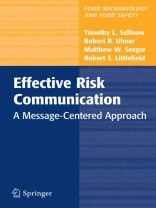Coordination of risk assessments and risk communication strategies requires information sharing and establishing networks of working relationships between groups and agencies. Establishing these relationships necessitates overcoming – stitutional, cultural, and political boundaries. Signi?cant barriers exist between r- ulatory agencies and industry groups. Traditionally, these groups have mistrusted one another, and cooperation and collaboration, including sharing information, c- respondingly has been limited. The adoption of radio frequency identi?cation te- nology for tracking livestock, for example, has been met with signi?cant resistance due in part to mistrust between regulatory agencies and producers (Veil, 2006). In the food industry, the need for coordination has been enhanced by industry in- gration and globalization of both markets and production. In the case of GM foods discussed earlier, disagreements between U. S. , European Union, and Canadian r- ulatory agencies fueled the debate over the safety of GM crops. Overcoming institutional and cultural barriers, and mistrust is necessary to create consistency in risk messages. Open communication and information sharing can help clarify where risk perceptions diverge and identify points of convergence. The outcome may not be universal agreement about risks, but convergence around the general parameters of risk. Summary These best practice strategies of risk communication are not designed to function as distinct steps or isolated approaches. Rather than being mutually exclusive, they serve to complement one another and create a coherent approach to confronting risk communication problems.
Inhaltsverzeichnis
Conceptualizing a Message-Centered Approach to Risk Communication.- Introducing a Message-Centered Approach to Risk Communication.- Best Practices for Risk Communication.- Multiple Audiences for Risk Messages.- Cases in Risk Communication.- The Case Study Approach.- Cryptosporidium: Unanticipated Risk Factors.- Hurricane Katrina: Risk Communication in Response to a Natural Disaster.- New Zealand Beef Industry: Risk Communication in Response to a Terrorist Hoax.- Odwalla: The Long-Term Implications of Risk Communication.- Con Agra: Audience Complexity in Risk Communication.- Applications of a Message-Centered Approach to Risk Communication.- Toward a Practice of Mindfulness.- Ethical Considerations in Risk Communication.- Future Directions.Über den Autor
Timothy L. Sellnow is a Professor Risk Communication in the Department of Communication at the University of Kentucky, Lexington, Kentucky.Robert R. Ulmer is a Professor of Communication and Chair in the Department of Speech Communication at the University of Arkansas–Little Rock, Little Rock, Arkansas.
Matthew Seeger is a Professor of Communication and Chair in the Department of Communication at Wayne State University, Detroit, Michigan.
Robert S. Littlefield is a Professor Communication in he Department of Communication at North Dakota State University, Fargo, North Dakota.
Sprache Englisch ● Format PDF ● Seiten 185 ● ISBN 9780387797274 ● Dateigröße 1.3 MB ● Verlag Springer New York ● Ort NY ● Land US ● Erscheinungsjahr 2008 ● herunterladbar 24 Monate ● Währung EUR ● ID 2146340 ● Kopierschutz Soziales DRM












